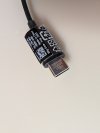TheWalkman
Senior Member
- Joined
- Jan 9, 2020
- Messages
- 479
- Likes
- 1,331
For the price of a couple of packs of gum, you get to enjoy music out of your phone.
I’ll bank my chewing gum allowance and splurge for the Apple dongle.
I’ll bank my chewing gum allowance and splurge for the Apple dongle.
